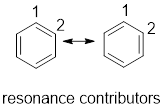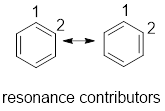
Concept explainers
(a)
Interpretation:
From the given compounds, compounds having delocalised electrons have to be identified.
Concept Introduction:
Delocalized electrons: Electrons that are not localized in one particular atom or bond and shared by three or more atoms are called delocalized electrons.
Resonance contributor: In some chemical compounds like benzene pi electrons are delocalized in it and difficult to locate it. Resonance contributor gives an idea of where about of pi electrons. The exact structure with localized electrons are called resonance contributor.

(a)
Interpretation:
From the given compounds, resonance contributor for compounds having delocalised electrons have to be drawn.
Concept Introduction:
Delocalized electrons: Electrons that are not localized in one particular atom or bond and shared by three or more atoms are called delocalized electrons.
Resonance contributor: In some chemical compounds like benzene pi electrons are delocalized in it and difficult to locate it. Resonance contributor gives an idea of whereabouts of pi electrons. The exact structure with localized electrons are called resonance contributor.

Want to see the full answer?
Check out a sample textbook solution
Chapter 7 Solutions
EP ESSENTIAL ORG.CHEM.-MOD.MASTERING
- Calculate the pH and the pOH of each of the following solutions at 25 °C for which the substances ionize completely: (a) 0.000259 M HClO4arrow_forwardWhat is the pH of a 1.0 L buffer made with 0.300 mol of HF (Ka = 6.8 × 10⁻⁴) and 0.200 mol of NaF to which 0.160 mol of NaOH were added?arrow_forwardDetermine if the following salt is neutral, acidic or basic. If acidic or basic, write the appropriate equilibrium equation for the acid or base that exists when the salt is dissolved in aqueous solution. If neutral, simply write only NR. Be sure to include the proper phases for all species within the reaction. NaN₃arrow_forward
- A. Draw the structure of each of the following alcohols. Then draw and name the product you would expect to produce by the oxidation of each. a. 4-Methyl-2-heptanol b. 3,4-Dimethyl-1-pentanol c. 4-Ethyl-2-heptanol d. 5,7-Dichloro-3-heptanolarrow_forwardWhat is the pH of a 1.0 L buffer made with 0.300 mol of HF (Ka = 6.8 × 10⁻⁴) and 0.200 mol of NaF to which 0.160 mol of NaOH were added?arrow_forwardCan I please get help with this.arrow_forward
- Determine if the following salt is neutral, acidic or basic. If acidic or basic, write the appropriate equilibrium equation for the acid or base that exists when the salt is dissolved in aqueous solution. If neutral, simply write only NR. Be sure to include the proper phases for all species within the reaction. N₂H₅ClO₄arrow_forwardPlease help me with identifying these.arrow_forwardCan I please get help with this?arrow_forward
 Organic Chemistry: A Guided InquiryChemistryISBN:9780618974122Author:Andrei StraumanisPublisher:Cengage Learning
Organic Chemistry: A Guided InquiryChemistryISBN:9780618974122Author:Andrei StraumanisPublisher:Cengage Learning
